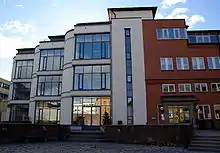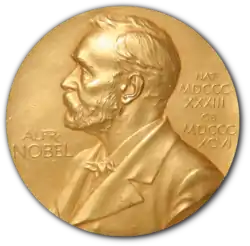Dag Hammarskjöld
Dag Hjalmar Agne Carl Hammarskjöld (/ˈhæmərʃʊld/ HAM-ər-shuuld,[1] Swedish: [ˈdɑːɡ ˈhâmːarˌɧœld] (![]() listen); 29 July 1905 – 18 September 1961) was a Swedish economist and diplomat who served as the second Secretary-General of the United Nations. As of 2021, Hammarskjöld remains the youngest person to have held the Secretary-General post, having been only 47 years old when he was appointed in 1953. His second term was cut short when he died in the crash of his DC-6 airplane in Northern Rhodesia while en route to cease-fire negotiations during the Congo Crisis. He is the only person in history to be awarded a Nobel Peace Prize posthumously.[2]
listen); 29 July 1905 – 18 September 1961) was a Swedish economist and diplomat who served as the second Secretary-General of the United Nations. As of 2021, Hammarskjöld remains the youngest person to have held the Secretary-General post, having been only 47 years old when he was appointed in 1953. His second term was cut short when he died in the crash of his DC-6 airplane in Northern Rhodesia while en route to cease-fire negotiations during the Congo Crisis. He is the only person in history to be awarded a Nobel Peace Prize posthumously.[2]
Dag Hammarskjöld | |
|---|---|
 Hammarskjöld in the 1950s | |
| 2nd Secretary-General of the United Nations | |
| In office 10 April 1953 – 18 September 1961 | |
| Preceded by | Trygve Lie |
| Succeeded by | U Thant |
| Personal details | |
| Born | Dag Hjalmar Agne Carl Hammarskjöld 29 July 1905 Jönköping, Sweden |
| Died | 18 September 1961 (aged 56) Ndola, Northern Rhodesia, Federation of Rhodesia and Nyasaland (now Ndola, Zambia) |
| Cause of death | Airplane crash |
| Nationality | Swedish |
| Father | Hjalmar Hammarskjöld |
| Alma mater | Uppsala University Stockholm University |
| Signature | |
Hammarskjöld has been referred to as one of the two best secretaries-general of the United Nations,[3] and his appointment has been mentioned as the most notable success for the UN.[4] U.S. President John F. Kennedy called Hammarskjöld "the greatest statesman of our century."[5]
Early life and education
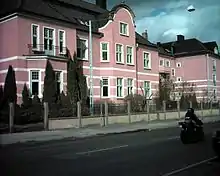
Dag Hammarskjöld was born in Jönköping to the noble family Hammarskjöld (also spelled Hammarskiöld or Hammarsköld). He spent most of his childhood in Uppsala. His home there, which he considered his childhood home, was Uppsala Castle. He was the fourth and youngest son of Hjalmar Hammarskjöld, Prime Minister of Sweden from 1914 to 1917.[6]
Hammarskjöld studied first at Katedralskolan and then at Uppsala University. By 1930, he had obtained Licentiate of Philosophy and Master of Laws degrees. Before he finished his law degree he had already obtained a job as Assistant Secretary of the Unemployment Committee.[7]
Career
From 1930 to 1934, Hammarskjöld was Secretary of a governmental committee on unemployment. During this time he wrote his economics thesis, "Konjunkturspridningen" ("The Spread of the Business Cycle"), and received a doctorate from Stockholm University. In 1936, he became a secretary in Sweden's central bank, the Riksbank. From 1941 to 1948, he served as chairman of the Riksbank's General Council.[8]
Hammarskjöld quickly developed a successful career as a Swedish public servant. He was state secretary in the Ministry of Finance 1936–1945, Swedish delegate to the Organization for European Economic Cooperation 1947–1953, cabinet secretary for the Ministry of Foreign Affairs 1949–1951 and minister without portfolio in Tage Erlander's government 1951–1953.[8]
He helped coordinate government plans to alleviate the economic problems of the post-World War II period and was a delegate to the Paris conference that established the Marshall Plan. In 1950, he became head of the Swedish delegation to UNISCAN, a forum to promote economic cooperation between the United Kingdom and the Scandinavian countries.[9] Although Hammarskjöld served in a cabinet dominated by the Social Democrats, he never officially joined any political party.[8]
In 1951, Hammarskjöld was vice chairman of the Swedish delegation to the United Nations General Assembly in Paris. He became the chairman of the Swedish delegation to the General Assembly in New York in 1952. On 20 December 1954, he was elected to take his father's vacated seat in the Swedish Academy.[10]
United Nations Secretary-General
Nomination and election
On 10 November 1952 Trygve Lie announced his resignation as Secretary-General of the United Nations. Several months of negotiations ensued between the Western powers and the Soviet Union, without reaching an agreement on his successor. On 13 and 19 March 1953, the Security Council voted on four candidates. Lester B. Pearson of Canada was the only candidate to receive the required majority, but he was vetoed by the Soviet Union.[11][12] At a consultation of the permanent members on 30 March 1953,[13] French ambassador Henri Hoppenot suggested four candidates, including Hammarskjöld, whom he had met at the Organisation for European Economic Cooperation.[14]
The superpowers hoped to seat a Secretary-General who would focus on administrative issues and refrain from participating in political discussion. Hammarskjöld's reputation at the time was, in the words of biographer Emery Kelèn, "that of a brilliant economist, an unobtrusive technician, and an aristro-bureaucrat". As a result, there was little to no controversy in his selection;[15] the Soviet permanent representative, Valerian Zorin, found Hammarskjöld "harmless".[16] Zorin declared that he would be voting for Hammarskjöld, surprising the Western powers.[17] The announcement set off a flurry of diplomatic activity. British Foreign Secretary Anthony Eden was strongly in favor of Hammarskjöld and asked the United States to "take any appropriate action to induce the [Nationalist] Chinese to abstain."[18] (Sweden recognized the People's Republic of China and faced a potential veto from the Republic of China.) At the U.S. State Department, the nomination "came as a complete surprise to everyone here and we started scrambling around to find out who Mr. Hammarskjold was and what his qualifications were."[19] The State Department authorized Henry Cabot Lodge Jr., the US Ambassador, to vote in favor after he told them that Hammarskjöld "may be as good as we can get."[20][21]
Hammarskjöld: "This April Fool's Day joke is in extremely bad taste: it's nonsense!"
–Exchange between a Stockholm journalist and Hammarskjöld, 1 April 1953[15]
On 31 March 1953, the Security Council voted 10-0-1 to recommend Hammarskjöld to the General Assembly, with an abstention from Nationalist China.[22] Shortly after midnight on 1 April 1953, Hammarskjöld was awakened by a telephone call from a journalist with the news, which he dismissed as an April Fool's Day joke.[lower-alpha 1] He finally believed the news after the third phone call.[14] The Swedish mission in New York confirmed the nomination at 03:00 and a communique from the Security Council was soon thereafter delivered to him.[23] After consulting with the Swedish cabinet and his father, Hammarskjöld decided to accept the nomination.[22] He sent a wire to the Security Council:[24]
With strong feeling personal insufficiency I hesitate to accept candidature but I do not feel I could refuse to assume the task imposed on me should the [UN General] Assembly follow the recommendation of the Security Council by which I feel deeply honoured.
Later in the day Hammarskjöld held a press conference at the Swedish Foreign Ministry. According to diplomat Sverker Åström, he displayed an intense interest and knowledge in the affairs of the UN, which he had never shown any indication of before.[24]
The U.N. General Assembly voted 57-1-1 on 7 April 1953 to appoint Dag Hammarskjöld as Secretary-General of the United Nations. Hammarskjöld was sworn in as Secretary-General on 10 April 1953.[22] He was unanimously reelected on 26 September 1957 for another term, taking effect on 10 April 1958.[25]
Tenure
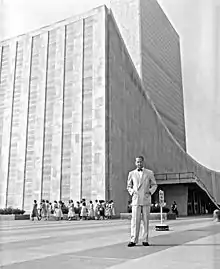
Immediately following the assumption of the Secretariat, Hammarskjöld attempted to establish a good rapport with his staff. He made a point in going to every UN department to shake hands with as many workers as possible, eating in the cafeteria as often as possible, and relinquishing the Secretary-General's private elevator for general use.[26] He began his term by establishing his own secretariat of 4,000 administrators and setting up regulations that defined their responsibilities. He was also actively engaged in smaller projects relating to the UN working environment. For example, he planned and supervised every detail in the creation of the meditation room at the UN headquarters. This is a place dedicated to silence, where people can withdraw into themselves, regardless of their faith, creed, or religion.[27]
During his term, Hammarskjöld tried to improve relations between Israel and the Arab states. Other highlights include a 1955 visit to China to negotiate the release of 11 captured US pilots who had served in the Korean War,[6] the 1956 establishment of the United Nations Emergency Force, and his intervention in the 1956 Suez Crisis. He is given credit by some historians for allowing participation of the Holy See within the United Nations that year.[28]
In 1960, the newly independent Congo asked for UN aid in defusing the Congo Crisis. Hammarskjöld made four trips to Congo, but his efforts toward the decolonisation of Africa were considered insufficient by the Soviet Union; in September 1960, the Soviet government denounced his decision to send a UN emergency force to keep the peace. They demanded his resignation and the replacement of the office of Secretary-General by a three-man directorate with a built-in veto, the "troika." The objective was, citing the memoirs of Soviet leader Nikita Khrushchev, to "equally represent interests of three groups of countries: capitalist, socialist and recently independent."[29][7]
Death
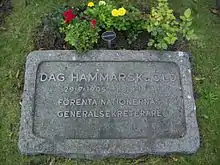
On 18 September 1961, Hammarskjöld was en route to negotiate a cease-fire between United Nations Operation in the Congo forces and Katangese troops under Moise Tshombe. His Douglas DC-6 airliner SE-BDY crashed near Ndola, Northern Rhodesia (now Zambia). Hammarskjöld perished in the crash, as did all but one of the 16 passengers, who died from injuries a few days later. Hammarskjöld's death set off a succession crisis at the United Nations,[30] as there was no line of succession and the Security Council had to vote on a successor.[31]
The circumstances of the crash are still unclear. A 1962 Rhodesian inquiry concluded that pilot error was to blame, while a later UN investigation could not determine the cause of the crash.[32] There is evidence suggesting the plane was shot down.[33][34][35] A CIA report claimed the KGB was responsible.[36]
The day after the crash, former U.S. President Harry Truman commented that Hammarskjöld "was on the point of getting something done when they killed him. Notice that I said 'when they killed him'."[36]
In 1998, documents surfaced suggesting CIA, MI6, and/or Belgian mining interest involvement via a South African paramilitary organization. The information was contained in a file from the South African National Intelligence Agency turned over to the South African Truth and Reconciliation Commission in relation to the 1993 assassination of Chris Hani, leader of the South African Communist Party. These documents included an alleged plot to "remove" Hammarskjöld and contained a supposed statement from CIA director Allen Dulles that "Dag is becoming troublesome … and should be removed." Hammarskjöld's mission to end the war over the mineral-rich Katangese secession from the newly formed Republic of the Congo was contrary to the interests of those organizations. However these documents were copies rather than originals, precluding substantiation of authenticity through ink and paper testing.[32]
Göran Björkdahl, a Swedish aid worker whose father worked for the UN in Zambia, wrote in 2011 that he believed Hammarskjöld's death was a murder committed, in part, to benefit mining companies like Union Minière, after Hammarskjöld had made the UN intervene in the Katanga crisis. Björkdahl based his assertion on interviews with witnesses of the plane crash near the border of the DRC with Zambia and on archival documents.[37][38]
In 2013 accident investigator Sven Hammarberg was asked by the International Commission of Jurists to investigate Hammarskjöld's death.[39]
In 2014, newly declassified documents revealed that the American ambassador to the Congo sent a cable to Washington D.C. warning that the plane could have been shot down by Belgian mercenary pilot Jan van Risseghem, commander of the small Katanga air force. Van Risseghem died in 2007.[34]
On 16 March 2015, United Nations Secretary-General Ban Ki-moon appointed members to an Independent Panel of Experts to examine new information related to Hammarskjöld's death. The three-member panel was led by Mohamed Chande Othman, the Chief Justice of Tanzania, and included Kerryn Macaulay (Australia's representative to the ICAO) and Henrik Larsen (a ballistics expert from the Danish National Police).[40] The panel's 99-page report, released 6 July 2015, assigned "moderate" value to nine new eyewitness accounts and transcripts of radio transmissions. Those accounts suggested that Hammarskjöld's plane was already on fire as it landed and that other jet aircraft and intelligence agents were nearby.[41]
In 2016, the original documents from the 1998 South African investigation surfaced. Those familiar with the investigation cautioned that even if authentic, the documents could have been initially authored as part of a disinformation campaign.[32]
In 2019, the documentary film Cold Case Hammarskjöld revealed that the previously named pilot Van Risseghem told a friend that he shot down Hammarskjöld's aircraft.[42][43][44] The film also named a paramilitary white supremacy group who claimed involvement. Van Risseghem had extensive ties to Britain, including a British mother and wife, had trained with the RAF, and was decorated by Britain for his service in the Second World War.[44]
In Hammarskjöld's 1959 will he left his personal archive to the National Library of Sweden.[45]
Personal life
Following his appointment as UN Secretary-General, Hammarskjöld carried a copy of the oath of office with him on his travels. It was found in one of his books in the Ndola crash site.[46]
Spirituality and Markings
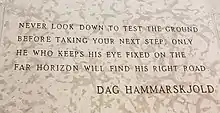
In 1953, soon after his appointment as United Nations Secretary-General, Hammarskjöld was interviewed on radio by Edward R. Murrow. In this talk Hammarskjöld declared:
But the explanation of how man should live a life of active social service in full harmony with himself as a member of the community of spirit, I found in the writings of those great medieval mystics [Meister Eckhart and Jan van Ruysbroek] for whom 'self-surrender' had been the way to self-realization, and who in 'singleness of mind' and 'inwardness' had found strength to say yes to every demand which the needs of their neighbours made them face, and to say yes also to every fate life had in store for them when they followed the call of duty as they understood it.[47]
Hammarskjöld's only book, Vägmärken (Markings, or more literally Waymarks), was published in 1963. A collection of his diary reflections, the book starts in 1925, when he was 20 years old, and ends the month before his death in 1961.[48] This diary was found in his New York house, after his death, along with an undated letter addressed to then Swedish Permanent Under-Secretary for Foreign Affairs, Leif Belfrage. In this letter, Hammarskjöld wrote:
These entries provide the only true 'profile' that can be drawn ... If you find them worth publishing, you have my permission to do so.
The foreword is written by the English poet W. H. Auden, a friend of Hammarskjöld's.[49]
Markings was described by the late theologian Henry P. Van Dusen as "the noblest self-disclosure of spiritual struggle and triumph, perhaps the greatest testament of personal faith written ... in the heat of professional life and amidst the most exacting responsibilities for world peace and order."[50] Hammarskjöld wrote, for example:
We are not permitted to choose the frame of our destiny. But what we put into it is ours. He who wills adventure will experience it – according to the measure of his courage. He who wills sacrifice will be sacrificed – according to the measure of his purity of heart.[51]
Markings is characterised by Hammarskjöld's intermingling of prose and haiku poetry in a manner exemplified by the 17th-century Japanese poet Basho in his Narrow Roads to the Deep North.[52] In his foreword to Markings, W. H. Auden quotes Hammarskjöld as stating:
In our age, the road to holiness necessarily passes through the world of action.[53]
The Evangelical Lutheran Church in America commemorates the life of Hammarskjöld as a renewer of society, on the anniversary of his death, 18 September.[54]
Legacy
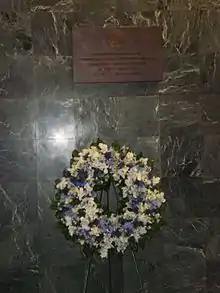
Honors
- Honorary degrees: Carleton University in Ottawa (then called Carleton College)[55] awarded its first-ever honorary degree to Hammarskjöld in 1954, when it presented him with a Legum Doctor, honoris causa. The University has continued this tradition by conferring an honorary doctorate upon every subsequent Secretary-General of the United Nations. He also held honorary degrees from Oxford University, United Kingdom; in the United States from Harvard, Yale, Princeton, Columbia, the University of Pennsylvania, Amherst, Johns Hopkins, the University of California, and Ohio University; in Sweden, Uppsala University; and in Canada from McGill University as well as Carleton University, in Ottawa.[56]
People's views
- John F. Kennedy: After Hammarskjöld's death, U.S. president John F. Kennedy regretted that he had opposed the UN policy in the Congo and said: "I realise now that in comparison to him, I am a small man. He was the greatest statesman of our century."[5]
- In 2011, The Financial Times wrote that Hammarskjöld has remained the benchmark against which later UN Secretaries-General have been judged.[57]
Named structures
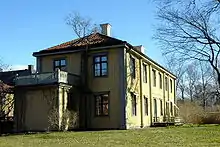
- Buildings and rooms:
- Stanford University: Dag Hammarskjöld House, on the Stanford University campus, is a residence cooperative for undergraduate and graduate students with international backgrounds and interests at Stanford.[58]
- Hammarskjold High School: Public Middle School located in the town of Thunder Bay, Ontario, Canada.
- Hammarskjold Middle School: Public Middle School located in the town of East Brunswick, New Jersey.
- Dag Hammarskjöld Middle School: Public Middle School located in the town of Wallingford, Connecticut.[59]
- Streets:
- Hammarskjöldplatz is the wide square to the north entrance of the Messe Berlin fairgrounds in Berlin, Germany.[60]
- Dag Hammarskjöld Plaza is a public park near the headquarters of the United Nations in New York City.[61]
Other commemorations
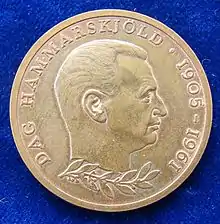

- Dag Hammarskjöld Foundation: In 1962, the Dag Hammarskjöld Foundation was created as Sweden's national memorial to Dag Hammarskjöld.[62]
- Memorial awards:
- Medal: On 22 July 1997, the U.N. Security Council in resolution 1121(1997) established the Dag Hammarskjöld Medal in recognition and commemoration of those who have lost their lives as a result of UN peacekeeping operations.[63]
- Prize in Peace and Conflict Studies: Colgate University annually awards a student the Dag Hammarskjöld Prize in Peace and Conflict Studies based on outstanding work in the program.[64]
- Postage stamps: Many countries issued postage stamps commemorating Hammarskjöld.[65]
- On 6 April 2011, Sweden's central bank, the Riksbank, announced that Hammarskjöld's image would be used on the 1000-kronor banknote, the highest-denomination banknote in Sweden.[66] The new currency was introduced in 2015.[67]
Depictions in popular culture
In the 2016 The Siege of Jadotville, depicting the events of the Congo Crisis,[68] Hammarskjöld is played by his fellow countryman actor Mikael Persbrandt.
See also
Notes
- The nomination was leaked early by a delegate of the Security Council, who informed a correspondent of the vote as they left the council chamber to go to the restroom.[23] Earlier in March, Hammarskjöld had discussed the succession problem of the UN Secretariat with artist Bo Beskow. When Beskow suggested that Hammarskjöld would be suitable for the office, the latter replied, "Nobody is crazy enough to propose me—and I would be crazy to accept."[24]
References
- "Hammarskjöld". Collins English Dictionary. HarperCollins.
- "Nobel Prize facts". Nobel Foundation. Retrieved 13 May 2020.
- "Next U.N. secretary general - The Japan Times". This article names Kofi Annan as the other one.
- "How Not to Select the Best UN Secretary-General". 28 October 2015.
- Linnér, Sture; Åström, Sverker (2008). UN Secretary-General Hammarskjöld: Reflections and Personal Experiences (The 2007 Dag Hammarskjöld Lecture) (PDF). Uppsala University. p. 28. ISBN 978-91-85214-51-8. Catalog record archived from the original on 22 July 2019. "This is the translated text of the 2007 Dag Hammarskjöld Lecture given by Sture Linnér and Sverker Åström at Uppsala University on 15 October 2007".
- Sze, Szeming (December 1986). Working for the United Nations: 1948–1968 (Digital ed.). Pittsburgh: University of Pittsburgh. p. 20. Retrieved 7 November 2014.
- "Biography, at Dag Hammerskjoldse". Daghammarskjold.se. Archived from the original on 2 October 2013. Retrieved 10 September 2013.
- "Dag Hammarskjöld", The Nobel Prize
- "Dag Hammarskjöld" [biography]. United Nations. United Nations. Retrieved 13 October 2017.
- "DAG HAMMARSKJÖLD: The UN years ..." United Nations. Retrieved 25 December 2019.
- Hamilton, Thomas J. (13 March 1953). "Soviet Veto Blocks Pearson U.N. Boom; Romulo Also Fails". The New York Times. p. 1.
- Hamilton, Thomas J. (20 March 1953). "Mme. Pandit Loses in Vote for Lie Post". The New York Times. p. 4.
- Barry, Donald, ed. (1953). Documents on Canadian External Relations, 1953. 19. p. 322.
- Fröhlich, Manuel (2007). Political Ethics and The United Nations: Dag Hammarskjöld as Secretary-General. Routledge. p. 59. ISBN 9781134065561.
- Lipsey 2013, p. 117.
- Heller 2001, p. 14.
- Hamilton, Thomas J. (1 April 1953). "U.N. Chief is Picked". The New York Times. p. 1.
- FRUS 1952–1954 III, Document 213: Memorandum of Telephone Conversation, by the Deputy Director of the Office of United Nations Political and Security Affairs (Popper), 31 March 1953.
- FRUS 1952–1954 III, Document 216: Memorandum of Conversation, by the Deputy Assistant Secretary of State for United Nations Affairs (Sandifer), 30 April 1953.
- FRUS 1952–1954 III, Document 211: The United States Representative at the United Nations (Lodge) to the Department of State, 30 March 1953—1:38 p.m.
- FRUS 1952–1954 III, Document 212: Memorandum for the Files by the Assistant Secretary of State for United Nations Affairs (Hickerson), 30 March 1953.
- Heller 2001, p. 15.
- Lipsey 2013, pp. 117–118.
- Lipsey 2013, p. 118.
- Heller 2001, p. 21.
- Lipsey 2013, p. 135.
- Mary Cherif; Nathalie Leroy; Anna Banchieri; Armando Da Silva. "The Meditation Room in the UN Headquarters". United Nations. Retrieved 10 September 2013.
- "Holy See's Presence in the International Organizations". Vatican.va. 22 April 2002. Archived from the original on 15 February 2014. Retrieved 10 September 2013.
- Archived 22 October 2006 at the Wayback Machine
- Halberstam, David (19 September 1961). "Hammarskjold Dies in African Air Crash; Kennedy Going To U. N. In Succession Crisis". The New York Times. p. 1.
- Hamilton, Thomas J. (23 September 1961). "Interim U.N. Head is Urged by Rusk; His Timing Scored". The New York Times. p. 1.
- Lynch, Colum (1 August 2016). "U.N. to Probe Whether Iconic Secretary-General Was Assassinated". Foreign Policy. Retrieved 17 December 2017.
- Borger, Julian (17 August 2011). "Dag Hammarskjöld: evidence suggests UN chief's plane was shot down". The Guardian. Retrieved 2 August 2014.
- Borger, Julian (4 April 2014). "Dag Hammarskjöld's plane may have been shot down, ambassador warned". The Guardian. Retrieved 2 August 2014.
- Susan Williams, Who Killed Hammarskjold? 2011, Hurst Publishers, 2014, Oxford University Press
- Jamie Doward, "Spy messages could finally solve mystery of UN chief’s death crash", The Guardian 13 December 2014.
- Bjorkdahl, Goran (17 August 2011). "Dag Hammarskjöld: I have no doubt Dag Hammarskjold's plane was brought down". The Guardian. Retrieved 2 August 2014.
- Bjorkdahl, Goran (February 2013). "EYEWITNESSES: The Hammarskjold Plane Crash". International Peacekeeping. 20: 98–115. doi:10.1080/13533312.2013.763681. S2CID 144859006.
- Hammarberg, Sven (15 August 2013). "Accident Investigator's Report to the Hammarskjöld Commission" (PDF). Hammarskjöld Commission.
- "UN announces members of panel probing new information on Dag Hammarskjöld death". UN News Centre. 16 March 2015. Retrieved 18 March 2015.
- "Panel: Possible Aerial Attack on Hammarskjold Plane in 1961". The New York Times. Associated Press. 6 July 2015. Retrieved 6 July 2015.
- "More Clues, and Questions, in 1961 Crash That Killed Dag Hammarskjold". The New York Times. Retrieved 30 December 2019.
- "Mercenary admits to murder of Dag Hammarskjöld". SVT. Retrieved 13 January 2019.
- "RAF veteran 'admitted 1961 killing of UN secretary general'". The Guardian. Retrieved 13 January 2019.
- "L179 The Dag Hammarskjöld Collection". National Library of Sweden. Retrieved 16 June 2018.
- Lipsey 2013, p. 124.
- Henry P Van Dusen. Dag Hammarskjold: A Biographical Interpretation of Markings Faber and Faber London 1967 p. 47.
- Hartman, Thom (3 March 2005). Markings - the spiritual diary of Dag Hammarskjöld. BuzzFlash.
- Auden, with Leif Sjoberg, translated the book into English. Hammarskjold, Dag (1964). Markings. New York: Ballantine Books.
- Henry P Van Dusen. Dag Hammarskjold: A Biographical Interpretation of Markings Faber and Faber London 1967 p. 5
- Dag Hammarskjold: Markings Leif Sjoberg and WH Auden (trans) Faber and Faber London 1964 p. 63.
- Dag Hammarskjold: Markings Leif Sjoberg and WH Auden (trans) Faber and Faber London 1964 p149
- WH Auden Foreword to Dag Hammarskjold: Markings Leif Sjoberg and WH Auden (trans) Faber and Faber London 1964 p. 23.
- Gail Ramshaw, More Days for Praise: Festivals and Commemorations in Evangelical Lutheran Worship (Minneapolis: Augsburg Fortress, the publishing arm of the Evangelical Lutheran Church in America, 2016), p. 220.
- Carleton Through the Years Archived 12 May 2011 at the Wayback Machine. Retrieved 31 March 2011
- Mary Cherif; Nathalie Leroy; Anna Banchieri; Armando Da Silva. "Dag Hammarskjöld: The Un Years". United Nations. Retrieved 19 September 2011.
- Alec Russell (13 May 2011). "The road to redemption". Financial Times. Retrieved 14 May 2011.
- "Hammarskjold House". Stanford.edu. Archived from the original on 8 August 2011. Retrieved 19 September 2011.
- "Dag Hammarskjöld Middle School - Wallingford Public Schools". www.wallingford.k12.ct.us. Retrieved 23 October 2020.
- "Event Area North" (PDF). Messe Berlin. Archived from the original (PDF) on 18 February 2014. Retrieved 19 September 2013.
- "Neighborhood News". New York. 14 March 2011.
- "Convening thinkers and doers: Sweden's Dag Hammarskjold Foundation". Interenvironment.org. 25 November 1975. Archived from the original on 1 October 2011. Retrieved 19 September 2011.
- United Nations Security Council Verbatim Report 3802. S/PV/3802 22 July 1997. Retrieved 21 August 2007.
- "Colgate University : P-CON Fellowships and Awards". Colgate.edu. Retrieved 19 September 2011.
- Mary Cherif; Nathalie Leroy; Anna Banchieri; Armando Da Silva. "Selection of stamps commemorating the life of Dag Hammarskjöld". United Nations. Retrieved 10 September 2013.
- "Sveriges Riksbank/Riksbanken – Sweden's new banknotes and coins". Riksbank.com. Archived from the original on 27 September 2011. Retrieved 19 September 2011.
- "Sweden's New Bank Notes". unknown. Retrieved 8 January 2015.
- "28th Galway Film Fleadh – July 2016". Galwayfilmfleadh.com. Archived from the original on 23 November 2017. Retrieved 11 September 2016.
Bibliography
- Durel, Bernard, op, (2002), «Au jardin secret d'un diplomate suédois: Jalons de Dag Hammarskjöld, un itinéraire spirituel», La Vie Spirituelle (Paris). T. 82, pp. 901–922.
- Goodwin, Ralph R., ed. (1979), United Nations Affairs, Foreign Relations of the United States, 1952–1954, 3, Washington D.C.: United States Government Printing Office.
- Heller, Peter B. (2001). The United Nations under Dag Hammarskjold, 1953-1961. Scarecrow Press. ISBN 9781461702092.
- Kelen, Emery (1966) Hammarskjold. Putnam.
- Lichello, Robert (1972) "Dag Hammarskjold: A Giant in Diplomacy." Samhar Press, Charlotteville, N.Y. ISBN 978-0-87157-501-2.
- Lipsey, Roger (2013). Hammarskjöld: A Life (illustrated ed.). University of Michigan Press. ISBN 9780472118908.
- Urquhart, Brian, (1972), Hammarskjold. Alfred A. Knopf, New York.
- Velocci, Giovanni, cssr, (1998), «Hammarskjold Dag», in Luigi Borriello, ocd – Edmondo Caruana, ocarm – Maria Rosaria Del Genio – N. Suffi (dirs.), Dizionario di mistica. Libreria Editrice Vaticana, Città del Vaticano, pp. 624–626.
External links
| Wikimedia Commons has media related to Dag Hammarskjöld. |
| Wikiquote has quotations related to: Dag Hammarskjöld |
- Dag Hammarskjold papers at the United Nations Archives
- Death of Dag Hammarskjöld on UN Archives website
- Dag Hammarskjöld – biography, quotes, photos and videos
- UNSG Dag Hammarskjold Conference on 9–10 November 2011 at Peace Palace
- UNSG Ban Ki-Moon Lays Wreath Honouring Dag Hammarskjold of 1 October 2009 and UNSG with King Carl XVI Gustaf of Sweden
- UNSG Kofi Annan, Dag Hammarskjöld and the 21st century, The Fourth Dag Hammarskjöld Lecture 6 September 2001, Dag Hammarskjöld Foundation and Uppsala University (pdf)
- About Dag Hammarskjöld (Dag Hammarskjöld Foundation)
- United Nations Secretaries-General
- Dag Hammarskjöld, Secretary-General at the official website of the UN
- Dag Hammarskjöld on Nobelprize.org

- Letters say Hammarskjöld's death Western plot
- Media briefing by Archbishop Desmond Tutu
- 18 September 1961 UN Secretary-General Dag Hammarskjöld is killed and BBC
- Audio of Dag Hammarskjold's response to Russian pressure From UPI Audio Archives
- Dag Hammarskjöld's FBI files hosted at the Internet Archive
| Cultural offices | ||
|---|---|---|
| Preceded by Hjalmar Hammarskjöld |
Swedish Academy, Seat No.17 1954–1961 |
Succeeded by Erik Lindegren |
| Positions in intergovernmental organisations | ||
| Preceded by |
April 1953 – September 1961 |
Succeeded by |
| Awards and achievements | ||
| Preceded by Albert Lutuli |
Laureate of the Nobel Peace Prize 1961 |
Succeeded by Linus Pauling |
